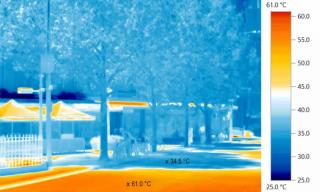Heat Islands - the local environmental concern you may not know about...

Cities and towns can be their own climates, often hotter than surrounding areas due to the way their surfaces like asphalt trap and radiate heat, and the ways in which cars and buildings exude heat.
When an area of a city or town is markedly warmer than surrounding areas, it is called a heat island – an area of greater heat absorption from buildings, pavements, and human activities.
A lot of the problem can be traced to the loss of a town’s tree canopy from over development, disease, or property owners’ landscape preferences. According to National Geographic, temperatures on exposed streets compared to tree canopied ones tend to be anywhere from 5 degrees to 15 degrees F cooler. The thermal image above shows the cooling effect of tree shade along a boulevard in Melbourne, Australia.
Even on the hottest days of summer, some neighborhoods can feel comparatively refreshing next to the more sunbaked areas of town, where there is little to no shade. According to the US Department of Agriculture, the cooling impact of a single healthy street tree is equal to 10 room-size air conditioners operating round the clock!
Heat islands can negatively affect a community’s environment and quality of life in multiple ways. Elevated temperatures significantly increase demand and costs for air conditioning to cool buildings. They add to increased overall and peak energy demand which can result in rolling brownouts or blackouts to avoid power outages. Heat islands contribute to higher daytime temperatures, reduced nighttime cooling, and higher air-pollution levels, which in turn, contribute to heat-related illnesses such as respiratory difficulties, heat exhaustion, and heat stroke. They also exacerbate the impact of naturally occurring heat waves, when sensitive populations such as children, older adults, and those with existing health conditions, are particularly at risk during these periods of abnormally hot weather.
Of course, trees impact our lives and environment in other significant ways, by improving our air and water quality, reducing stormwater runoff, mitigating flooding and lessening the effects of droughts.
For more about heat island effects and the critical role that trees play in their mitigation, click here.

